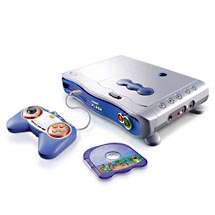I briefly spied a television commercial for a product called the V.Flash by VTech. The sound was off, but I got the impression that it was some kind of new game console for young children. And it appeared to have pretty decent graphical capabilities which is somewhat unexpected in this market.

Based on Google searches thus far, there doesn’t seem to be a big underground/hacking/homebrew scene developing around this new console yet. So it’s difficult to find hard technical data about it. Whatever the guts are made of, it must be possible to sell them at US$100 per unit and presumably make a profit. The 3D graphics aren’t especially revolutionary, but who can tell the difference in this day and age? In fact, based on screenshots and web videos I have seen thus far, the graphic quality strikes me as reminiscent of the PlayStation-N64 days. Further, the unit only supports composite A/V output.
Here is the PDF manual for the V.Flash console. As you can see from the above marketing photo, the system uses optical media in a cartridge, which is affectionately termed a V.DiscTM. The manual describes that the console comes with a tray onto which a user can mount an audio CD (and apparently a photo CD). This implies that the unit has the optical hardware to read CDs. I think it’s reasonable that it does not also read DVDs or else they would probably be able to advertise DVD playback capability. Plus, DVD playback ability would markedly increase costs via parts and technology licensing costs.
Naturally, I’m interested to see if the CDs have any FMV. The games are apparently widespread wherever fine toys are sold. They are around US$30 each and the company has managed to publish an impressive line-up of licensed titles featuring such properties as Spider-Man, Spongebob Squarepants, and Disney Princesses. It seems reasonable that one of these discs could be separated from its cartridge relatively easily and read in a normal PC’s optical drive.
What’s the wager that the unit contains, at its heart, an x86_32-type CPU? Then again, the V.Flash comes from a company that is hardly a startup and appears to have years of experience making small, game-related devices.
I’ll take that wager.
The original VSmile was an ARM core. See:
http://www.eclipse.org/org/foundation/membersminutes/20060921MembersMeeting/ARM.pdf
I believe EDNmag even had a small article on the design (although I can’t locate it on their site), which mentioned that the first implementations were done in a FPGA to meet their time-to-market goals.
I’ll be surprised if the V.Flash isn’t basically the same architecture and software, albeit with slightly different peripherals.
Note: VTech is also an ARCcore licensee. I presume that this is for their telco division (they have a market presence in the VoIP and portable phone markets), but they might also be redeploying it here.
Considering these guys are basically trying to make high-yield (ie. small die size, low gate count) chips which are battery powered, x86 architecture just isn’t a candidate.
Do a search on google like this…
+”zevio” +”v.flash” and you turn up the following:
The system is based on a custom LSI Logic S.O.aC. [ZEVIO 1020] which likely has a MIPS or ARM core [likely an ARM9]. It also has a graphics engine and a stock LSI logic DAC for audio work and video decoding [likely ZSP400 with a default encoding scheme of H.264 bp] and a 2D/3D midi engine. The system is utterly cacheless [save for the requirements of the cpu core and a scratch cache for the DAC/DSP to save chip realestate, but that doesn’t seem to make too big of a negative impact on performance. The main memory appears to be SDRAM, granted running at 150 mhz. The core clock appears to be a base of 150 mhz as well.
The web page link is to the tech specs on LSIs website.
Can the CD be put in the music cd case and loaded in the system?
It would be interested to see if the cd could be copied to a CD-R, and work in the system. Also, it would be interesting if a text string in the program could be changed.
These two things should rule out copy protection (or encrypted checksumming) of the CD.
@CDoty: Not sure about any of these things since I have not taken the plunge yet and bought an actual system.
I should have a system coming in the next day or two. Hoepfully I can get something going..
I got it in today. It will load from a CD-R and CD-RW, but requires the V-Disk case.
The title screen does mention LSI. The 3d graphics core is Koto. They also list Mascot Capsule, which is a Java 3D technology.
I’ve put together a quick page to detail what I find out about the v.flash system.
It’s located at:
http://vflash.emuvibes.com/
I just wanted to say, the system will easily boot a game from the music CD tray if you tape down the button on the front right inside the systems CD tray.